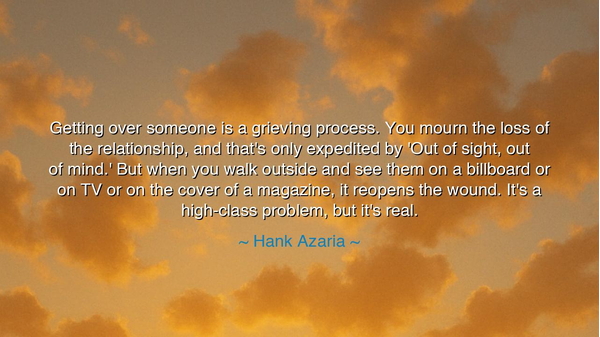
Getting over someone is a grieving process. You mourn the loss
Getting over someone is a grieving process. You mourn the loss of the relationship, and that's only expedited by 'Out of sight, out of mind.' But when you walk outside and see them on a billboard or on TV or on the cover of a magazine, it reopens the wound. It's a high-class problem, but it's real.






In the words of Hank Azaria, actor and storyteller, we are reminded that the breaking of bonds is no light matter: “Getting over someone is a grieving process. You mourn the loss of the relationship, and that's only expedited by 'Out of sight, out of mind.' But when you walk outside and see them on a billboard or on TV or on the cover of a magazine, it reopens the wound. It's a high-class problem, but it's real.” Here is the recognition that love lost is not unlike death, for what is gone cannot be held, and yet its memory lives on, stirring pain each time it reappears before the eyes.
At the heart of this saying is the truth that love’s ending is grief’s beginning. When a relationship dies, something of the soul dies with it. Just as mourners grieve the passing of one who has departed from this life, so the heart grieves when a beloved departs from its embrace. There are rituals of letting go—silence, distance, forgetting. The old wisdom of “Out of sight, out of mind” speaks to this: remove the presence, and healing begins. But Azaria points to the torment of modern times, when the face of the beloved may appear at any moment—on a billboard, on a screen, on a magazine cover—dragging the heart back into sorrow.
The ancients knew this pain as well. The poets of Greece spoke of Orpheus, who lost his beloved Eurydice to death, and though he sought to bring her back, he failed. Every whisper of her name, every shadow of her presence, was a wound that never fully healed. So too do lovers across ages find that though time moves forward, the image of the lost one can appear suddenly, reopening what was thought to be mended. The grief of love is not linear—it returns in waves, and one must endure until its power lessens.
History offers us countless tales of hearts pierced by memory. Consider Napoleon Bonaparte, who, though conqueror of nations, could not conquer his longing for Joséphine. Even after their divorce, when he sought political gain in marriage to another, he carried her name upon his lips. To the end of his life, in exile on Saint Helena, he whispered for her. His grief was never fully silenced, for her image lived within him as Azaria describes: a wound reopened again and again by memory, presence, and sight.
Azaria also names it a “high-class problem,” for he speaks as one whose work and world often thrust him among faces seen by millions. Yet the wisdom beneath this jest is universal: grief wears many masks, but the pain is the same for rich and poor, for the exalted and the humble. To lose love is to lose part of oneself, and no station in life grants immunity. The billboard may be different for each—perhaps a familiar street corner, a shared café, or a song on the radio—but the effect is the same: the wound reopens, and the heart must bleed again.
The lesson for us is clear: to lose love is to grieve, and we must allow ourselves the dignity of that grief. Do not mock your sorrow, nor belittle it, for it is the price of having loved deeply. Know that memories will arise, images will appear, and wounds will sting again. Yet also know that with time, each reopening is less sharp, each pang less enduring, until the heart becomes stronger, not because it forgets, but because it has learned to carry both the love and the loss together.
Practically, this means giving yourself patience in healing. Do not demand instant recovery. Step away when you can, guard your mind when possible, but also accept that reminders will come. When they do, breathe deeply, acknowledge the pain, and let it pass without clinging. Surround yourself with new sights, new voices, new companions, until your life grows larger than the wound. And in that expansion, you will find room not only for grief but for joy once more.
So let us remember Hank Azaria’s wisdom: getting over someone is a grieving process, and though reminders may reopen the wound, healing is real. To mourn is not weakness but testimony to the power of love. To endure the reopening of sorrow is to prove the resilience of the heart. And in time, the wound that once bled will become a scar—not an absence, but a reminder that you lived, you loved, and you endured.






AAdministratorAdministrator
Welcome, honored guests. Please leave a comment, we will respond soon